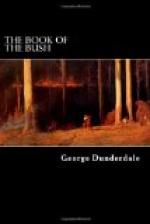“But, Jack, what have you been doing since I met you the year before last? You had a train of pack bullocks and a mob of cattle, looking for a run about Mount Buninyong. Did you start a station there for Imlay?”
“No, I didn’t. I found a piece of good country, but Pettit and the Coghills hunted me out of it, so Imlay sold the cattle, and went back to Twofold Bay. Then Charles Lynot offered me a job. He was taking a mob of cattle to Adelaide, but he heard there was no price for them there, so he took up a station at the Pyrenees, seventeen miles beyond Parson Irvine’s run at the Amphitheatre. I was there about twelve months. My hut was not far from a deep waterhole, and the milking yard was about two hundred yards from the hut. The wild blacks were very troublesome; they killed three white men at Murdering Creek, and me and Francis, Clarke’s manager, hunted them off the station two or three times. The blacks were more afraid of Francis than of anybody else, as besides his gun he always carried pistols, and they never could tell how many he had in his pockets. Cockatoo Bill’s tribe drove away a lot of Parson Irvine’s sheep, and broke a leg of each sheep to keep them from going back. The Parson and Francis went after them, and one of our stockmen named Walker, and another, a big fellow whose name I forget. They shot some of the blacks, but the sheep were spoiled.
“There was a tame blackfellow we called Alick, and two gins, living about our station, and he had a daughter we called picaninny Charlotte, ten or eleven years old, who was very quick and smart, and spoke English very well. One morning, when I was in the milking yard, she came to me and said, ’You look out. Cockatoo Bill got your axe under his rug—sitting among a lot of lubras. Chop you down when you bring up milk in buckets.’




